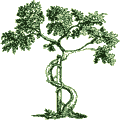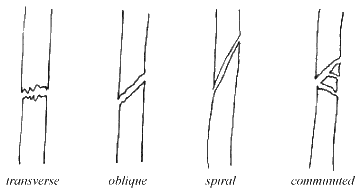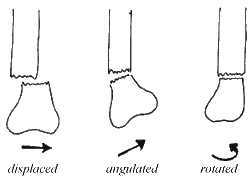
|
|||||||
Fractures
A fracture can be described by its appearance on X-rays. In a long bone of any limb (where most fractures occur), a transverse fracture occurs when the fracture line is transverse across the shaft of the bone (perpendicular to the long axis of the bone) - usually a result of a bending injury. An oblique fracture occurs when the fracture line is oblique across the shaft of the bone -usually a result of a combination bending and twisting injury. A spiral fracture occurs when the fracture line spirals around the shaft of the bone - a result of a pure twisting injury. A comminuted fracture occurs when the bone is broken into more than two fragments.

If the fracture fragments are in good position, the fracture is called an undisplaced fracture. Sometimes the fracture line is so fine that it is called a hairline fracture. If there is displacement of the fracture fragments, it is called a displaced fracture. A displaced fracture may axially displaced, angulated or rotated.

With severe trauma, there may be disruption of the muscles and skin, causing the fracture to communicate with the external environment - an open or compound fracture. Most fractures do not communicate with the external environment because the skin is not broken - a closed fracture.
There are also special circumstance fractures.
- A stress fracture occurs when a bone is subject to repeated stress, e.g., from running or marching. This is also called a fatigue fracture.
- A pathological fracture occurs when minor stress is placed upon a bone that is weakened by pre-existing disease, e.g., bone affected by osteoporosis, or a bone cyst, or cancer cells.
- An avulsion fracture occurs when a muscle-tendon unit exerts such traction force on the bone it is attached to, that it avulses off a piece of bone. This is more frequent in children and adolescents where the muscle-tendon unit is stronger than the bone. It happens typically around the hip and knee.
- A greenstick fracture occurs only in children, because of the increased elasticity of young bones. The fracture is an incomplete fracture that goes partly through the bone, leaving part of the cortex and periosteum (covering) of the bone intact. It is comparable to trying to break a young green twig. It tends to bend and break partially, rather than snap, as in a dry twig (like an old bone). If a compressive force is applied on a child's bone, e.g., when he falls on the outstretched hand, it buckles the bone just above the wrist, giving an expanded appearance on X-rays. This is a type of greenstick fracture, called a buckle fracture or torus fracture.
- An epiphyseal injury (or fracture) occurs at the epiphyseal plate or growth plate at the ends of the long bones, that happens in children and adolescents. They are sometimes called Salter fractures, because Dr. Robert Salter from Toronto first classified these injuries.
NOTICE: The information presented is for your information only, and not a substitute for the medical advice of a qualified physician. Neither the author nor the publisher will be responsible for any harm or injury resulting from interpretations of the materials in this article.
Questions
or comments? Post your thoughts in the Orthoseek
Message Forum!
Find a pediatric orthopedic surgeon
in an area near you.
Home | About Us | Orthopaedic Topics | Message Forum
![]()
Comments, questions, or suggestions are welcome. Please
contact us using this form.